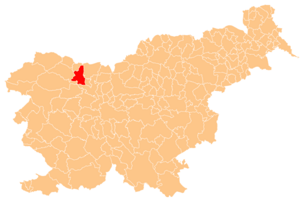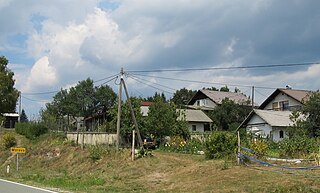| Spodnji Otok | |
|---|---|
| Coordinates: 46°20′44″N14°13′23″E / 46.34556°N 14.22306°E Coordinates: 46°20′44″N14°13′23″E / 46.34556°N 14.22306°E | |
| Country | |
| Region | Upper Carniola |
| Statistical region | Upper Carniola |
| Municipality | Radovljica |
| Elevation | 494 m (1,621 ft) |
| Population (2002) | |
| • Total | 147 |
| [1] | |
Spodnji Otok (pronounced [ˈspoːdnji ˈɔːtɔk] ) is a village in the Municipality of Radovljica in the Upper Carniola region of Slovenia.

The Municipality of Radovljica is a municipality in the Upper Carniola region of northern Slovenia. The administrative centre of the municipality is the town of Radovljica. The municipality has around 18,000 inhabitants and an area of 118 square kilometres (46 sq mi). It is located at the southern slope of the Karawanks mountain range at the confluence of the Sava Dolinka and the Sava Bohinjka, both headwaters of the Sava River.

Upper Carniola is a traditional region of Slovenia, the northern mountainous part of the larger Carniola region. The centre of the region is Kranj, while other urban centers include Jesenice, Tržič, Škofja Loka, Kamnik, and Domžale. It has around 300,000 inhabitants or 14% of the population of Slovenia.

Slovenia, officially the Republic of Slovenia, is a sovereign state located in southern Central Europe at a crossroads of important European cultural and trade routes. It is bordered by Italy to the west, Austria to the north, Hungary to the northeast, Croatia to the southeast, and the Adriatic Sea to the southwest. It covers 20,273 square kilometers (7,827 sq mi) and has a population of 2.07 million. One of the successor states of the former Yugoslavia, Slovenia is a parliamentary republic and a member of the United Nations, of the European Union, and of NATO. The capital and largest city is Ljubljana.
Contents
A document from 1326 mentions the village Otok as Werd. Between 1326 and 1331 two members of Polish gentry, Jurij and Nikolaj, moved to the area and Jurij had his mansion in Spodnji Otok. Part of this lineage is mentioned as living in the area during the early period of reign of the Counts of Celje. [2]

The Poles, commonly referred to as the Polish people, are a nation and West Slavic ethnic group native to Poland in Central Europe who share a common ancestry, culture, history, and are native speakers of the Polish language. The population of self-declared Poles in Poland is estimated at 37,394,000 out of an overall population of 38,538,000, of whom 36,522,000 declared Polish alone.

Gentry are "well-born, genteel and well-bred people" of high social class, especially in the past. In the United Kingdom, the term gentry refers to the landed gentry, the majority of the land-owning social class who were typically armigerous, but did not have titles of nobility. Gentry, in its widest connotation, refers to people of good social position connected to landed estates, upper levels of the clergy, and "gentle" families of long descent who never obtained the official right to bear a coat of arms. The historical term gentry by itself, so Peter Coss argues, is a construct that historians have applied loosely to rather different societies. Any particular model may not fit a specific society, yet a single definition nevertheless remains desirable. Linguistically, the word gentry arose to identify the social stratum created by the very small number, by the standards of Continental Europe, of the Peerage of England, and of the parts of Britain, where nobility and titles are inherited by a single person, rather than the family, as usual in Europe.

A mansion is a large dwelling house. The word itself derives through Old French from the Latin word mansio "dwelling", an abstract noun derived from the verb manere "to dwell". The English word manse originally defined a property large enough for the parish priest to maintain himself, but a mansion is no longer self-sustaining in this way. Manor comes from the same root—territorial holdings granted to a lord who would "remain" there—hence it is easy to see how the word mansion got its meaning.











